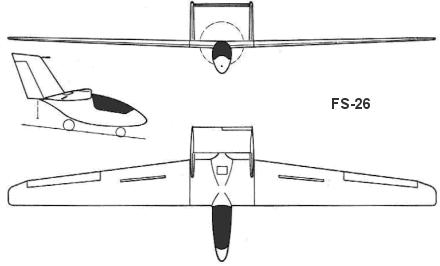| http://www.survol.cjb.net |
Akaflieg Stuttgart FS-26
 |
| FS-26 in flight |
| click on the picture to enlarge it in a new window) |
Designed and built by the Stuttgart Akademische Fliegergruppe (Akaflieg) in Germany, the FS-26 was an experimental single-seater, aimed at investigating the characteristics of a motorglider equipped with a reflex airfoil and a separate horizontal stabilizer (this formula will be used a few years later on the Genesis sailplane). Made of fibreglass, the FS-26 re-used the cockpit of the Phoebus sailplane modified to include the engine controls and instruments, and the long retractable landing gear. The aircraft was powered by a Hirth F10A engine, located at the rear of the fuselage. In soaring configuration, the propeller blades could be folded and the engine cowling openings were closed.
The wing used an Eppler 515 airfoil, and could be divided into three parts for trailering on the road. The connections between the fuselage and the wing had been carefully studied, as well as the engine cooling.
The FS-26 made its first flight on September 25, 1970. After several tests, this aircraft was donated to the Wasserkuppe Soaring Museum.
| Characteristics of the FS-26 | |
| Wing span | 12.60 m |
| Length | 3.94 m |
| Wing Area | 13.20 m2 |
| Airfoil | Eppler 515 |
| Empty weight | 250 kg |
| Max. weight | 360 kg |
